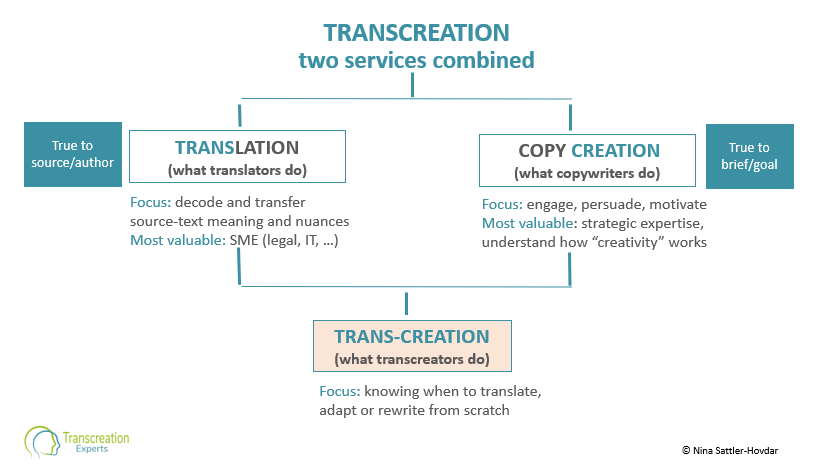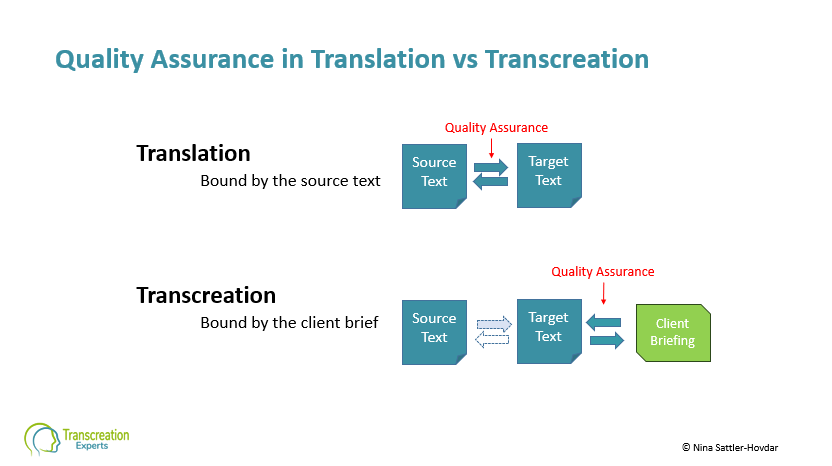What you should know if you intend to buy or sell transcreation services
Recently, I was asked to participate in an academic research project on transcreation.
Sharing my longstanding expertise with buyers, translators, and academia has always been important to me, so, I happily agreed. Yet it also made me realize that there is still a lot of confusion around transcreation, despite all the talks, articles, and books I (and others) have delivered over the last 20 years, so, I decided to recap some of the fundamentals.
+++
First, my definition of what transcreation is:
The general definition:
Transcreation is when translation (what translators have been trained to do) and copy creation (what copywriters have been trained to do) come together in one expert process.
The definition for clients:
Transcreation combines translation and copywriting processes and is required whenever you need impactful copy to engage, inspire, and motivate readers or customers in a market outside your home market. Due to the high visibility of these texts, and their impact on brand perceptions, reputation, and sales, it is paramount that your transcreation provider has actual marketing copywriting expertise in addition to translation expertise.
The definition for providers:
Transcreation as a combination of translation and copywriting is applicable to any text that, due to its impact on messaging effectiveness, requires the expertise to assess, based on a client briefing, how much of the source text should be taken to the target text and how much needs to be rewritten, and in what ways. The processes will differ substantially from standard translation agency processes.
The definition for academia:
Transcreation is a skill set that combines translation and copywriting, where translation is defined as focusing on accurately rendering source-text details and nuances in ways to give readers the full picture of what the source text says, while copywriting focuses solely on a target text and how to best engage and motivate readers in the target market to take a specific kind of action. Transcreation is the result of merging these two services into one.
Plus a definition of copywriting, as that is often misunderstood:
Copywriting is about selling messages in the most effective ways. Think of the copywriter as a salesperson who wants to gain a potential customer’s interest and has only a window of a few seconds to do so before that potential customer moves on.
Copywriting is an essential part of transcreation. In fact, transcreation processes are in many ways more akin to copywriting than translation processes.
Consequently, every transcreator needs to be trained in copywriting just as much as they need to be trained in translation.
To illustrate this combination of skill sets and services, I have developed the following overview:

Transcreation combines two professional services in one expert process
We see that transcreation combines two services that both require their own training and skill sets, and that are normally and have traditionally been provided by two different service providers or entities.
While I am aware that not everyone in the translation business agrees with this (somewhat simplified) definition, it is the one that makes most sense to people outside the translation universe, that is, to clients. And those are really the ones we need to convince and get on board.
In the above illustration, we see that translation is focused on decoding and transferring source-text meanings and nuances. Generally, the most valuable skill a translator can bring to the table in addition to translation expertise is subject-matter expertise (SME). Specialization in a field or niche. Also, translators are essentially bound by the source text and/or the author. Think of a contract — readers want to know exactly what the source-text contract says, they want to fully understand all the subtleties and details and nuances. The same goes for, say, fiction literature (you probably didn’t think of that, did you?). That’s because authors of novels are proud of their work and want the translators to reflect all the nuances that they have carefully crafted in their source texts, mimicking the same style and tone as closely as possible. Creativity and accuracy will be required but the translator shouldn’t rewrite anything.
Whereas copy creation (aka copywriting) is focused on engaging, persuading and motivating readers to take specific action. The transcreator needs to have the expertise to understand how and when to adapt and rewrite a source text (“copy” in marketing parlance) to achieve a defined messaging and marketing goal. Think high-visibility ad campaigns, websites, blog articles etc. In copywriting, the binding reference is the briefing, what the client wants to achieve, taking into account particularities of the target market. The source text will be merely a reference — an important one at that, but essentially no more than a non-binding guideline.
Subject-matter expertise, while important in translation, is often not so much of a requirement or even desired in transcreation. Personally, I have clients who come to me specifically because I am not an expert in their particular niche and also don’t have the “tainted” inside company view, making me the ideal candidate for conveying messages to reach people outside their bubbles and jargons. In that role, I am effectively someone from the outside just like their target group. In order to be the ideal transcreator for this kind of work, you need deep research and interviewing skills, you need to know what kind of questions and follow-up questions to ask, you should also have a very broad generalist background and many interests. And of course you need to know how to work with briefings, how to assemble a briefing, how to interpret and apply them, how buyer psychology works and more.
One thing I need to insist on in this context, because that is one of the many misconceptions out there: Copywriting is not about fancy words or fun wordplay, or writing academic papers or literary works. Copywriting is a business thing, its focus is on selling messages, with everything that comes with that.
So, in a nutshell, a transcreator is a translator with a salesperson mindset.
+++
Secondly, what are the main challenges to overcome in transcreation?
In my experience, the main challenges encountered in transcreation are:
- Clients, agencies, and translators who do not (fully) understand when, why, and how to adapt texts for other markets to make them as effective as in the home markets.
- Lack of understanding on all sides that there is substantial communication needed to come up with the ideal final target text.
- Lack of understanding of processes, timelines, budgets, briefings, feedback loops.
- The importance of having direct lines of communication with the relevant marketing and sales people, ideally in both the home and target markets, is often underestimated.
- To achieve optimum results, transcreators need to be given freedom to use their tools and approaches as they see fit in each case rather than being forced to use inadequate tools dictated by translation agencies.
- Transcreation is often misunderstood as being all about fancy wordplay when in fact it is a highly strategically oriented task.
- Budgets are often set based on typical translation or translation editing fees. Due to the combination of services, these are not applicable. For transcreation, project fees are recommended (or hourly fees, if project fees aren’t possible).
- Agencies as go-betweens often impede the necessary dialog.
+++
Thirdly, what requirements should be met to ensure optimally executed transcreation jobs?
To ensure that transcreation jobs are performed to optimum standards, a “Transcreation Code of Practice” should, as a minimum, include the following (non-exhaustive list):
- Training: Transcreators should be professionally trained in both translation and copywriting (not just writing in a general sense but actual copywriting).
- Teaching: Transcreation instructors must have a professional understanding of effective messaging in the business world and have experience working with marketing/advertising/PR copy.
- Awareness: All parties involved in any given transcreation job need to be clear that transcreation tools and processes differ from those used in translation, as they are generally more akin to copywriting tools and processes.
- Client Involvement: Clients need to be available to provide relevant background information, visuals, and explanations of what they are looking for (“Briefing”), and to review and give feedback on first drafts.
- Binding Instructions: The client’s briefing, including visuals, brand voice styleguides and other instructions take precedence over the source text.
- Deliverables: In addition to delivering target copy, transcreators should always explain their messaging recommendations and provide relevant rationales. They also need to be prepared to adapt deliverables based on client feedback as part of standard service procedure.
- Quality Assurance: QA reviews should always be performed in relation to the briefing, not the source text.
To illustrate the quality assurance aspect, as one example of how processes differ between translation and transcreation, I have developed the following (again, somewhat simplified) overview:

How quality assurance in transcreation differs from the quality assurance process in translation
Because translation, as defined above, is bound by the source text, the quality assurance is carried out by reviewing the target text in comparison to the source text, checking for misunderstandings, omissions, additions, terminologies and other failures to accurately and completely render all the details and nuances of the source text.
For transcreation jobs, the quality assurance is carried out on the target text in relation to the briefing documentation. How well does the target text fufill the requirements set out in that documentation? The arrows between source and target text are therefore shown only a tenuous lines — the source text is taken into account but isn’t as binding as the client’s briefing.
+++
While the above definitions and explanations are just touching on some of the most fundamental aspects in transcreation, it is generally recognized that:
When done right, transcreation helps marketing and sales people in their efforts to improve brand interactions and user experience, increase qualified leads, sales and long-term loyalty, and reduce customer churn.
+++
I hope this article helps to better understand fundamental principles that all parties to high-visibility marketing-focused texts should be aware of. If you’re interested in diving deeper, check out my books and my course on transcreation, follow me on LinkedIn, or get in touch with questions how I can help you with transcreation needs or trainings.
Top Picture: Table of Contents from the book “Get fit for the future of transcreation” by Nina Sattler-Hovdar







